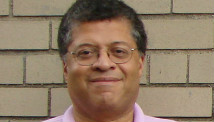Slain teen Hadiya Pendleton was remembered today as a laughing youth who brought love and happiness to all her family and friends.
Despite the heavy security because of the attendance of first lady Michelle Obama and other dignitaries, Hadiya's funeral at the Greater Harvest Baptist Church only occasionally touched on politics and the gun violence that ended Hadiya's life, instead focusing on a 15-year-old girl whose smile lit up the room.
Her mother, Cleopatra Cowley-Pendleton, briefly spoke to the standing room only crowd, often with a smile and even a laugh.
“My baby did all this,’’ she said, wearing a big red flower on her chest and a sparkly scarf, and clearly enjoying the music. "This is all Hadiya.’’
“The outpouring of support has been absolutely amazing,’’ she said.
She explained that at points, “you kinda do not know how to act,’’ and some people might not understand “our sense of humor’’ or “why I have a smile on my face.’’
“But I’m not worried about her soul,’’ she said.
“I just want to say thank you. Thank you to everyone who had something to do with rounding her or having something to do with who she was,’’ she said.
Then appearing more serious, she said, “No mother, no father should ever have to experience this.’’
“I kept her living,’’ she said, saying she helped her daughter stay away from negative influences. "When your children try to talk to you, listen. Don’t judge them. This should be a judge-free zone. You made them. You deal with that."
“All right, I love you all,’’ she said before ending her remarks.
Earlier the crowd was addressed by Damon Stewart, Hadiya's godfather, who said, “I’m going to speak as if we’re family,’’ adding that he had “two spiritual thoughts’’ he wanted to stress.
“God makes no mistakes,’’ he said. “I don’t believe in coincidence; I believe in divine intervention.’’
Wearing a black suit and black shirt, he also wore purple in honor of Hadiya -- a purple tie and ribbon on his chest, and a purple handkerchief in chest pocket.
“I loved that child,’’ he said.
Stewart quoted Hadiya's father, Nathaniel Anthony Pendleton, as saying, "This isn't political, this is personal."
Then Stewart said: "This should break the hearts of everyone who has someone they love."
He said he read a Facebook post that said: "I'm not going to buy into the hype. What makes this girl so much better than the others?"
"She is important because all those other people who died are important," Stewart said. "She is important because all of the families who were silent, she speaks for them. She is a representative of the people across the nation who have lost their lives."
"Don't let this turn into a political thing. Keep it personal," he said. "A lot of politicians will try to wield it as a sword. They want to use it for votes."
While family and friends kept the focus on the 15-year-old girl who was shot dead in a South Side park, the first lady's appearance inevitably brought attention to anti-gun efforts nationwide.
The back of the funeral program has a copy of a handwritten note from President Barack Obama: "Dear Cleopatra and Nathaniel, Michelle and I just wanted you to know how heartbroken we are to have heard about Hadiya's passing. We know that no words from us can soothe the pain, but rest assured that we are praying for you, and that we will continue to work as hard as we can to end this senseless violence. God Bless.”
In addition to Michelle Obama, dignitaries in the crowd included Gov. Pat Quinn, Mayor Rahm Emanuel, Cook County Board President Toni Preckwinkle, Ill. Attorney General Lisa Madigan, Rev. Jesse Jackson, Secretary of Education Arne Duncan and Valerie Jarrett, senior adviser to Barack Obama.
Prior to the service, the first lady met privately with about 30 of Hadiya's friends and classmates, and then with members of Hadiya's family, according to a White House official.
Father Michael Pfleger spoke and called Hadiya an "innocent victim of gun violence,’’ asking, “When did we lose our soul?”
He told the crowd that “we must become like Jesus’’ and become “the interrupters’’ of genocide, an evil that is killing our children.
“Welcome home, sweet Hadiya. See you on the other side," he said.
Hadiya was killed Jan. 29 at Harsh Park, in the 4400 block of South Oakenwald Avenue, not far from the Obama family home. Although Hadiya and the friends that were with her had no gang ties, a gunman fired into the park in what police said was a gang-connected shooting causing her death to become a symbol of Chicago's gun violence.
But most of the funeral service was about Hadiya's life, and the love she brought to so many.
Hadiya's pastor, Courtney C. Maxwell from the Greater Deliverance Temple Church of Christ, opened the services about 11:15 a.m. after a heart-shaped balloon was placed near her casket.
He thanked everyone for being at the Greater Harvest Baptist Church, including elected officials. “The family says thank you and God bless you.’’ He asked for round of applause for the Pendleton family.
“Only God can keep you and strengthen you, for God is our refuge and our strength,’’ the pastor said.
The pastor said Hadiya was “genuine and real.’’
“She was energetic, loved music, loved the arts,’’ the pastor said.
After the pastor spoke, a female reverend dressed in white addressed the crowd and a choir behind her began singing.
“Blessed are they that mourn, for they shall be comforted,’’ she said, as the choir sang after her.
An assistant pastor read from scriptures: "She is more precious than rubies. … Her ways are of pleasantness.’’
Pastor Elder Eric Thomas of the host Greater Harvest Baptist Church described Hadiya as a “beloved angel.’’
“Her life has not been in vain,’’ Thomas said.
A female singer and organist the played a religious song, as about 30 others in the choir, all dress in white, stood and swayed gently from side to side before the large cross that was draped in white.
Kenya Edwards, who identified herself as a radio personality and a friend, read a poem called “Walking’’ written for Hadiya by Zora Howard, then said: “Ladies and gentlemen, it’s time for us to start walking. It’s time to take a stand.’’
Hadiya’s aunt Linda Wilks then spoke, asking, “What was inside Hadiya that connected her to those who didn’t know her?”
“It was her inner light’’ that connected her with humanity’s inner light, she said. “Light has power and has potent force,’’ and can cause "mankind to feel an inner awakening and a sense of love.’’
“Light can pursue darkness ... it diffuses darkness,’’
her aunt said. "Hadiya. The light.’’
Several girls who all identified themselves as Hadiya’s best friends got up, one by one, to share warm and funny and very sad memories.
One girl, Kaylen Jones, drew laughter when she said Hadiya’s mom “guilted me’’ into talking, then said one of the things she will remember most is Hadiya's smile.
“That smile lit up a room’’ she said. “It was the last thing I saw before they put her into the ambulance.’’
“I loved her. These past few weeks I felt like there’s a part of me missing,’’ Jones said.
“But she’s right here, whispering the answers to us in chemistry,’’ she said, drawing huge laughs and applause.
Another girlfriend, Giselle, was holding a tissue and broke down in tears, having to stop at least twice during her thoughts.
“Hadiya always pushed me to do my very best,’’ she said, wiping her eyes. “We were going to go to college together.’’
Giselle said after losing Hadiya she had tweeted to friends "I just wanted a last hug," and two days later "I had a dream that she gave me a hug."
“I believe that she came back and gave me a last hug,’’ she said.
Many others remembered her laughter and her smile. Others had short songs they sang to the crowd and shared favorite memories of her.
Her King College Prep majorette team also got up, and presented her jacket in a frame to Hadiya's mother, who embraced her in a long hug.
Kierrra Wilson, the captain of the majorette team, which had performed for festivities during the weekend before President Obama's second inauguration, spoke first.
“It’s really hard being up here,’’ she said. “Hadiya was close to all of us.’’
The entire team, dressed in their black and gold outfits, engaged in a group hug.
Another teammate also recalled the Washington trip, saying Hadiya never lost her sense of humor even though they were “so tired.’’
She said she would always remember Hadiya’s laughter, and told a story that caused the crowd to chuckle. “She tries to tell a scary story and nobody can believe it,’’ she said. "She had a little baby voice.’’
Hadiya’s cousin got up and told the crowd Hadiya often talked about college.
“She always wanted to go to Harvard,’’ he said, before reading a poem he wrote about her that included the lines: “Sweeter than a tomato from the garden of fruit. You will always be loved. ... Save a spot for me above."
Hadiya’s little brother spoke briefly, recalling how his big sister would think of funny names.
A Nation of Islam representative spoke, offering condolences and saying, “We have come here to celebrate the life and light of this star of God."
"We pray for peace. We thank God for this beautiful gift … Hadiya,’’ he said.
The service ended about 2:37 p.m. as pallbearers began to move the casket, covered in a white cloth emblazoned with a gold cross, and the choir continued singing.
“There's a new name written in glory,’’ one of the pastors said. “Thank you, God, for our angel Hadiya."
By 2:44 p.m. people were moving out of the church. After the service, the first lady remained seated until the immediate family was out of the church. She was then escorted out though a private exit and left without public comment.
Hundreds of mourners had lined up early today at the church in the Washington Park neighborhood, which was under tight security.
Guests who were invited by the family were given orange wristbands and were able to enter through a shorter security line. Classmates and friends of Pendleton were given green wristbands and allowed to enter through that same line.
Trinity Dishmon, 40, said her daughter Deja, 15, and Hadiya were close friends in middle school. The two girls stayed in touch and were texting about their upcoming 16th birthdays while Hadiya was in D.C. for the president's inauguration in January.
"Hadiya was a gift to everyone that knew her," Dishmon said, tearing up. "These last 12 days have been unbelievably numbing. It's not six degrees of separation anymore, it's one. It's just unreal."
Dishmon said she feared that the day was less about the teenager and more about a larger issue.
"This is Hadiya's day and should be about her -- not something sensational," Dishmon said. "But maybe by honoring her life we can help make a difference."
Inside the church, Hadiya’s silver casket was placed in the front, surrounded by flowers and two large hearts, one with her picture on it. Behind the casket, a TV screen showed pictures of Hadiya with her family, from birth to her teenage years.
A funeral director wearing a suit and white gloves came outside at 9:40 a.m. to announce to the hundreds still waiting in line that the church was “at capacity.” Those still in line could come in and view the body, he said, but would have to leave before the services.
The funeral procession arrived at about 9:45 a.m., including three limousines and dozens of cars.
The first lady’s motorcade pulled into the church parking lot at about 10:15 a.m. She went in through a separate side entrance at the rear of the church, stepping directly from a vehicle into the building.
The family filed down the aisle a little after 10 a.m. and viewed the body in the still open casket. The pastor led the procession down the aisle chanting "the Lord is my shepherd" as soft organ music played in the background.
Ushers walked down the aisle handing out tissues, and those without wristbands were asked to give up their seats so that family members could be seated in the sanctuary. Every seat was filled by 9:45 a.m.
Purple, Hadiya’s favorite color, is represented in many of the flowers in the church and the lining of her casket. Ushers handed out a glossy funeral program booklet printed on purple paper. The front cover says "Celebrating The Life Of ... Hadiya Zaymara Pendleton.” Inside are more than 50 photos of Hadiya throughout her life.
Her obituary printed in the booklet describes her work in the church and even her favorite foods: Chinese, cheeseburgers, ice cream and Fig Newtons. It includes tributes from her grandmother, her cousin and an aunt as well as close friends.
About 10:15 a.m., the funeral director came back out and announced to the hundreds still waiting in line that no one else would be allowed inside — not for the viewing or the funeral.
Even after those outside were told they would not be allowed in, many continued to gather around the church's front gate.
Some began to file out, having to hop over the metal barricades to exit the long line.
One man asked the funeral staff member if he could at least have a pamphlet from the funeral before he left.
"Oh sir, those are long gone. They only printed 1,500," the funeral staff member said.
Activists, religious groups and others passed out printed material to those standing in line. Some kept the papers, others were left on the snowy ground as some of the crowd left.
A group of people who were not allowed inside the church after it reached capacity stood outside in the freezing weather for hours as the funeral went on.
Police put up additional barricades near the church entrance gate to keep new people arriving back.
At 2 p.m. a few people trickled out of the church, including a handful of King College Prep majorettes. Police were not allowing anyone else in for the service, even as people left.
Some had been standing outside for hours, hunched over in the cold. The group continued to talk as the hours passed.
A number of police cars circled the block during funeral services -- including officers in vans, SUVs and undercover cars. Helicopters could be seen and heard overhead.
Michelle Obama's attendance puts Chicago solidly in the middle of a national debate over gun violence that has polarized Congress and forced President Obama to take his gun control initiatives on the road to garner more public support.
The first lady's visit is being seen not only as a gesture of condolence to the family but as part of an effort to draw attention and support for the president's gun initiatives.
But the visit also meant scores of security, police and Secret Service agents, metal detectors and other security measures.
The church is surrounded by an iron fence and all of the openings -- a pedestrian gate in the front, front and side doors to the church, and a driveway to the north -- are guarded by city police or men in white shirts, ties and long black coats. Chicago police vehicles -- two wagons, a handful of squads and SUVs -- guarded the outside of the church while other vehicles circle the block.
Chicago police staffing the event are wearing dress blues -- a blue overcoat with pockets that allow access to the duty belt, creased navy pants, and a hat.
King College Prep math and engineering teacher Alonzo Hoskins stood quietly in line with others. He said he taught Hadiya in his first-period geometry class, where he now has an empty desk.
"She was full of life," Hoskins said.
Nate Weathers, 16, Jeramy Brown, 16, and Antoine Fuller, 15, all stood in line to see their former classmate. The three young men said they attended Carter G. Woodson Middle School with Hadiya.
“This tears me up,” Fuller said. “She was my 7th grade crush.”
Brown described Hadiya as “sweet and innocent.”
“Something like this should have never happened to her,” Brown said.
Police took two men into custody after they got into an altercation near the back of the long line of mourners waiting to get into the church. One man was agitated, complaining about the long wait to get in. A second man confronted him and they began shoving each other before police intervened.
Local and national pool reports contributed.
chicagobreaking@tribune.com
Twitter: @chicagobreaking



